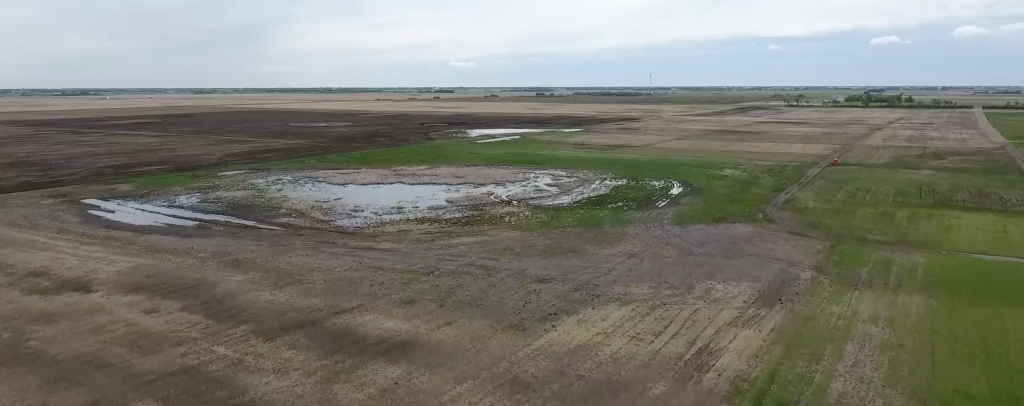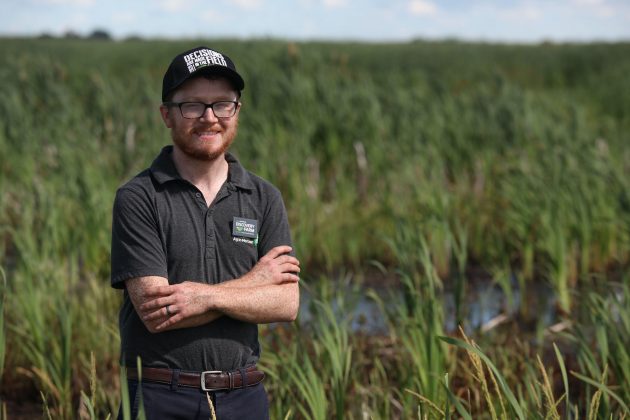
Features
Environment
Saskatchewan invests $1 million in agricultural water management research
The 11 demonstration projects will produce local science-based solutions for the province’s drainage questions.
July 23, 2020 By Stephanie Gordon
 Some of the demonstration projects will test how farmers and ranchers can irrigate with water drained from agricultural fields.
Some of the demonstration projects will test how farmers and ranchers can irrigate with water drained from agricultural fields. Saskatchewan, a province that is no stranger to the debate between drainage and conservation, is investing in local research that will help shape its drainage policy.
On July 20, Greg Ottenbreit, the minister responsible for the Water Security Agency (WSA), announced that WSA is investing $1 million to partner with 10 stakeholder organizations on 11 agricultural water management demonstration projects.
The funding will allow agricultural and environmental communities to test solutions and inform best practices to help farmers and ranchers manage water on their land. The research will look into how to mitigate water quality and quantity impacts downstream.
“Agricultural water management is extremely important to our economy and the environment, but every region of our province is different,” Ottenbreit said. “We need to listen and learn from, and work with farmers and ranchers on the landscape. These projects will allow stakeholders, WSA and local leaders to better understand how we can solve complex water management issues.”
“We need to listen and learn from, and work with farmers and ranchers on the landscape. These projects will allow stakeholders, WSA and local leaders to better understand how we can solve complex water management issues.”
The $1 million is mainly to help the projects monitor and collect data. The amount is complemented by additional funds from landowners, and there is more funding possible as projects progress over the years.
Part of a consistent effort toward better water management
In March 2019, the Saskatchewan government provided $5 million to the Saskatchewan Conservation and Development Association (SCDA) to help advance the Agricultural Water Management Strategy and develop more conservation authorities across the province.
The SCDA is a governing body aimed at improving responsible surface water management. It is the parent body to 96 conservation area authorities and districts as well as 13 water association boards, which collectively provide flood control for some 4.5 million acres of farmland.
“We have been working to advance agricultural water management projects for a number of years and it is great to see the government will be working with local leaders to find solutions to many of our members issues,” SCDA chair Miles Wendell said. “A lot of these projects take time and are very complex, so it’s good to see Water Security Agency taking this approach to demonstrate what works and what might need a different approach.”
The SCDA will work with the Water Security Agency to provide policy analysis and evaluation services to develop a draft of a mitigation policy.
“We’re hoping to develop the threshold approach to wetland loss that will address the concerns of Saskatchewan farmers, and ensure water quality, water habitat and impacts on downstream habitat are adequately considered,” Wendell said.
A closer look at one of the projects
Some of the demonstration projects will test how farmers and ranchers can irrigate with water drained from agricultural fields. Other projects will strategically retain wetlands to reduce the downstream impacts of
flooding on infrastructure, water quality and habitat. Others will look at applying fertilizer in different ways in order to minimize nutrient runoff.
The Glacier FarmMedia Discovery Farm, located northwest of Saskatoon in Langham, will host one of the projects. It will be the site of a multi-year study that will involve design, regulatory approval, and construction of a drainage system on approximately 40 acres of land. After construction, a field study will evaluate several management practices meant to reduce nutrient runoff.
“The goal is to design a drainage plan that meets regulatory requirements and optimizes land productivity while preserving the environment,” Blake Weiseth, applied research lead at the Discovery Farm, said. “This demonstration will help producers reclaim marginally productive low-lying areas while incorporating key nutrient management features associated with wetlands.”

Blake Weiseth, applied research lead at the Discovery Farm, says the field study will evaluate several management practices such as variable-rate fertilizer application and residue management. Photo courtesy of Glacier FarmMedia Discovery Farm.
Weiseth explained that the first year of the project will involve construction, in consultation with regulatory authorities, of drainage works on about 40 acres at the Discovery Farm. The construction will consolidate several small wetlands of varying classes into a larger, more permanent wetland.
“This is a unique opportunity to collect background soil chemical and physical characteristics prior to construction so we can truly evaluate the impact of drainage and management practices on wetland soils,” Weiseth said.
The field study will begin in spring 2021 to evaluate a number of management practices, said Weiseth. Proposed treatments include a poly-cropping treatment with a species mix including legumes to reduce nutrient losses through reduced fertilizer input; a variable-rate fertility prescription tailored to drained depressions to be applied at seeding; and a study of whether a residue management practice like harrowing will reduce nutrient losses by reducing interaction of snowmelt runoff water and surface crop residue. There will also be a control treatment using standard farming practices for comparison purposes.
“The entire two-year study is designed to give producers the opportunity to see what it takes to get regulatory approval for a drainage works, what obstacles might get in the way and how their management practices can improve the economics and environmental conditions of soils prone to flooding,” Weiseth added.
“The entire two-year study is designed to give producers the opportunity to see what it takes to get regulatory approval for a drainage works, what obstacles might get in the way and how their management practices can improve the economics and environmental conditions of soils prone to flooding,” Weiseth added.
The projects focus on surface drainage, not tile drainage, because it is most suitable for the Saskatchewan landscape.
Saskatchewan’s history with wetlands
According to Managing Saskatchewan Wetlands – A Landowner’s Guide, 11 percent of Canada’s wetlands are present in Saskatchewan. It is estimated there are about 1.5 million wetlands covering 4.2 million acres in the agricultural region of the province.
However, the report also notes that prairie wetlands are a diminishing resource “facing threats from drainage and degradation.” Since the time of settlement, the report reads, it has been estimated that Saskatchewan has lost 40 percent of its wetlands.
In late 2019, the Saskatchewan Water Security Agency began consulting stakeholders on a new Wetland Conservation Policy for agricultural land that would allow drainage to occur, but with limits designed to ensure preservation of wetland benefits.
The demonstration projects announcement will add to this work to produce Saskatchewan-relevant solutions to water management that appease all its stakeholders from agriculture, to wildlife, to conservation authorities.
“The majority of our members are from rural Saskatchewan and water management is important to wildlife across the province,” Saskatchewan Wildlife Federation executive director Darryl Crabbe said. “We are excited to partner with the Water Security Agency and other stakeholders to find solutions that work for wildlife and Saskatchewan farmers and ranchers.”
Updating drainage for today’s farmers
While the research is being done, the regulatory drainage process in the province will not be affected and continue to operate normally.
There won’t be much deduced from the projects that will impact policy for the first 18 months. Greg Ottenbreit, the minister responsible for the Water Security Agency, said the timeline for some of these projects range from one to five years.
“We don’t want to rush ahead too quickly on this, we want to make sure we have enough information to make science-based decisions while still moving forward aggressively to give some answers and direction to our producers,” Ottenbreit said.
“To get local science-based solutions to our drainage issues, that’s really what the whole thing is about,” added Lyle Stewart, Legislative Secretary to the Minister Responsible for Water Security Agency.
“We don’t have good local information based on the way we farm now,” Stewart explained, adding that farmers nowadays are employing tactics such as continuous cropping, cover crops, variable-rate nutrient applications, that help minimize nutrient runoff. Information obtained prior to the popularity of these conservation practices has the potential to be irrelevant, and Stewart said that the province needs up-to-date science on current conditions to make drainage decisions for its future.
“When you look at all the science we’re looking at and the information we’re trying to gather, we’ve come to realize that some of the best environmentalists are the agricultural producers themselves,” Ottenbreit said. Ottenbreit explained how the research will be all encompassing, going beyond wetlands and looking at how the different types of land add to habitat.
The research work will help answer how much mitigation is needed while balancing environmental and economic interests.
Print this page